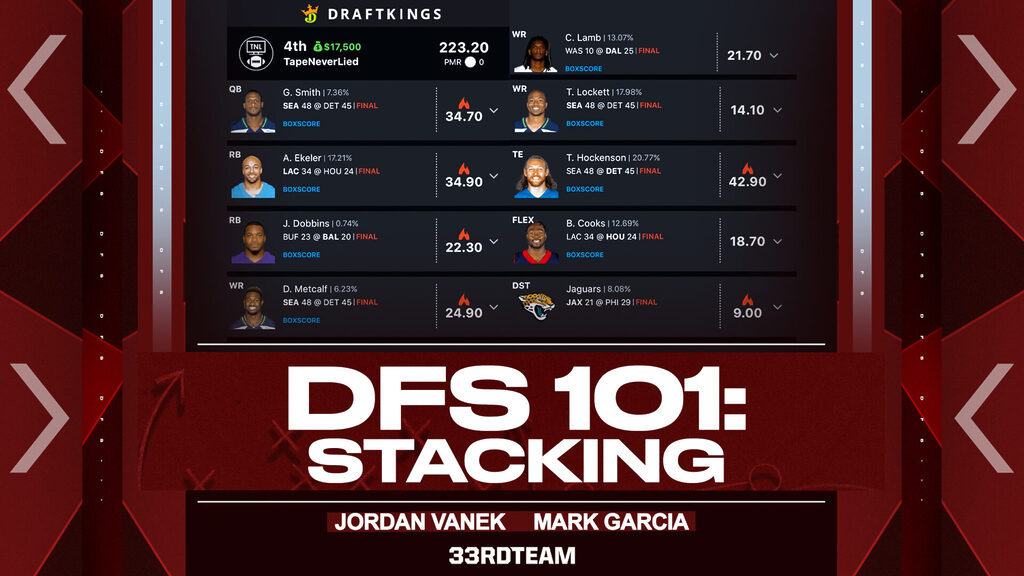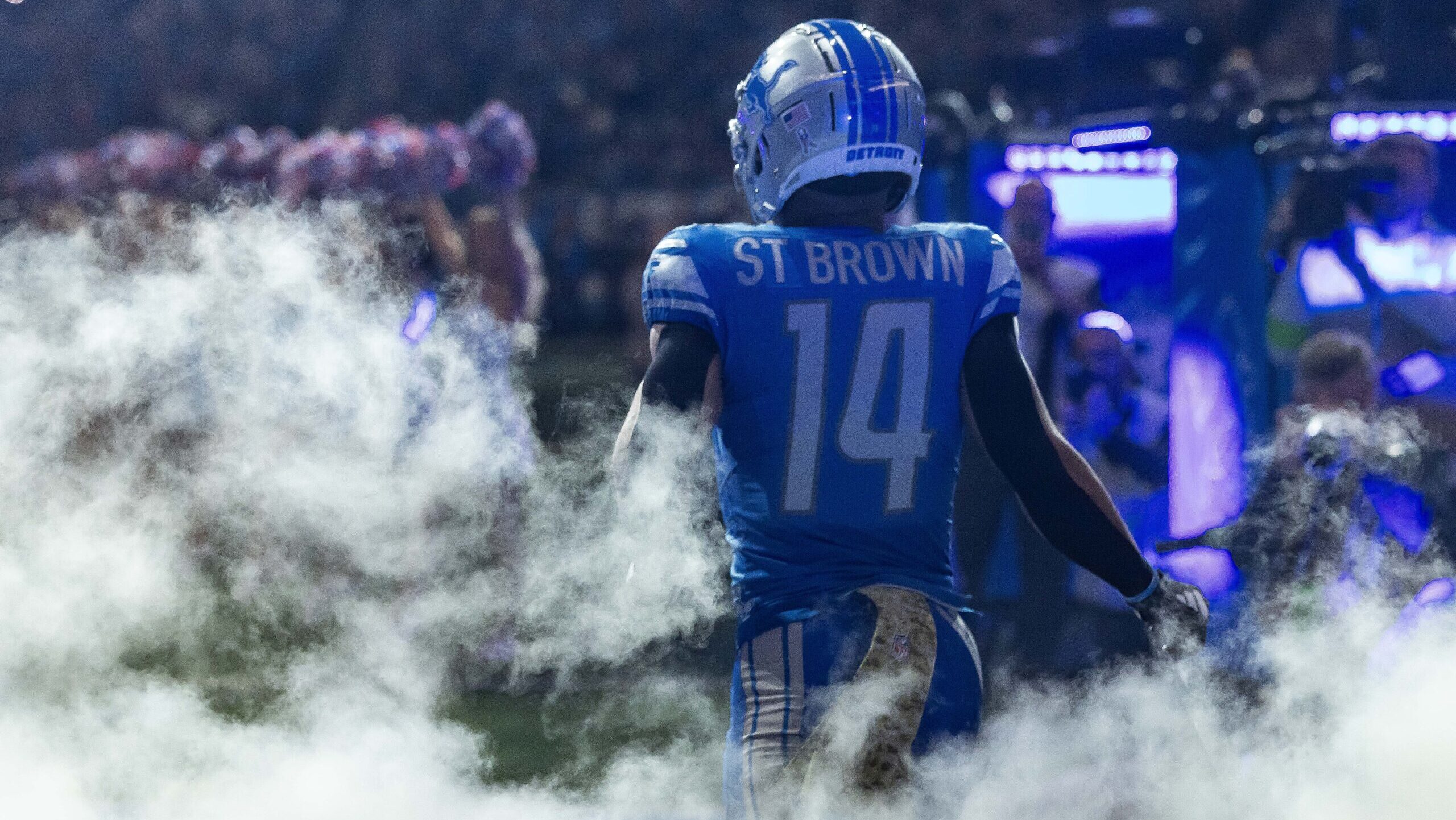Analysis
7/6/23
7 min read
Understanding Stacking in Daily Fantasy Football

In the Daily Fantasy Sports (DFS) world, stacking has become a popular and effective strategy for maximizing scoring potential. By selecting multiple players from the same team, fantasy players will benefit when those players perform well together.
We will delve into stacking, its importance in DFS, stacking strategies, factors that influence stack decisions and how to approach contrarian stacks for a competitive edge.
Understanding Stacking
What Is Stacking?
Stacking is a strategy where a fantasy player selects multiple players from the same team for their lineup.
Stacking aims to capitalize on the potential synergy and increased scoring opportunities that can arise when multiple players on the same team perform well.
Why Is Stacking Important?
Football and DFS carry immense levels of intrinsic variance. Stacking and, more importantly, correlating reduces the number of variables a roster needs to “get right” to capture bulk scoring.
Attacking game environments provides a path to multiple pieces approaching a more than 95 percent outcome together. For example, increased scoring typically results in additional offensive plays and increased aggression through the pace of play and pass rate, which directly results in other opportunities for fantasy points. - Garcia
Stacking is a vital strategy in DFS because you can create lineups that thrive in the specific game environment required for your players to achieve their highest potential.
When opting for a pocket-passing quarterback, it’s crucial to seek out two or more of their pass catchers, enabling you to capitalize on their strong connection and exploit scoring opportunities. Additionally, it’s advantageous to consider the opposing team’s standout players, as they can drive the game into a competitive situation where your pocket passer is forced to throw, thus increasing the chances of a productive fantasy performance.
By strategically stacking players, you create a synergistic lineup with the potential for ceiling weeks and a competitive edge. - Vanek
Favorite Ways to Stack
- Game Flow: RB/Opposing WR
- RB/DEF
- QB-WR-TE/OPP Player
- QB-RB-WR/OPP Player
From an analytical perspective, the QB/RB/pass-catcher/opposing pass-catcher offers the most leverage, which can be measured via the delta in win rate versus utilization rate from the field.
On the other hand, the RB/DEF correlation has been proven to provide little in the way of a boost to expected value. It’s completely overrated and overused by the field. But all of that depends on my analysis of a slate and where the field is going, which will heavily influence my decisions on leverage generation and variance manipulation. - Garcia
One of my preferred stacks involves pairing a quarterback with a wide receiver and a tight end from the opposing team. This strategy is based on the unique dynamics of the tight end position. As a tight end who achieves a 15-20 point output, excluding elite options like Travis Kelce, often provides more value than a wide receiver with similar production.
I prioritize building a stack that correlates with a player who outperforms their entire position, as it maximizes the potential for a successful lineup. Every stack presents an opportunity to capitalize on favorable circumstances and contribute to constructing a formidable tournament lineup. - Vanek
Factors Influencing Your Stacks
- Detail the key factors influencing your stack, such as player popularity, salary, matchup, injury news and expert recommendations.
- Contest selection
I’m what you would call a “bubble builder.” I spend the first 60 percent of the week forming my own opinions after an in-depth analysis of every game on the slate before venturing outside my “bubble” and looking at other rumblings from around the industry.
That’s important to my process because I can then factor in what the field is seeing on a given slate (rostership numbers, hype, etc.) to tailor my decision-making process. That’s a long way of saying I simply want to attack top spots in ways the field is unlikely to do frequently.
I’ll then utilize my portfolio for that slate to attack unique angles in games the field might be overlooking. That makes popularity and field exposure levels paramount to my process. - Garcia
When constructing my stacks, three crucial factors shape my decisions: salary, game flow and contest selection. I strive for a ceiling situation where my stack yields 0.004 points per dollar invested. With a target of 200 points for a top-tier lineup and a $50,000 budget, this equates to .004 points per dollar.
For example, a $20,000 stack should ideally deliver at least 80 points. Additionally, I consider the game flow and position-specific requirements. Running backs reliant on rushing attempts thrive when their team has a lead and goal-line opportunities.
On the other hand, wide receivers dependent on receptions excel in negative game scripts that generate high volume. Lastly, it’s important to consider the type of contest and how high of a rostership this stack will have. There are many ways to get unique, but I lean against playing some chalky stacks.
In an earlier article, we covered rostership and how that impacts our thought process. - Vanek
How to Handle Chalky Stacks
Building Contrarian Stacks
- Explain the concept of a contrarian approach in DFS and its benefits.
- Discuss how rostership projections can help identify low-owned players to differentiate your lineup and increase the chance of a unique stack.
I don’t necessarily concern myself with combinatorial ownership and individual player exposure levels because there is so much noise in those calculations.
For example, adding a player expected to garner one percent ownership to a stack can minimize the percentage of the field you are competing against. Rostering a player at 19 percent ownership and a player at one percent ownership is more unique than rostering two players at 10 percent ownership each (five times more unique, to be exact).
Thinking through “if-then” statements when building a roster is helpful. If a highly rostered wide receiver on a good offense in one of the top expected game environments on a slate fails, how did he fail? What caused him to fail? Is it likelier someone else on his team succeeded, or is it more reasonable his offense failed?
More often than not, someone else on his team is succeeding meaningfully. - Garcia
When it comes to going against the grain, it’s intriguing to analyze the price range and potential shortcomings of popular stacks, particularly focusing on their game dynamics or the less popular players involved.
If a commonly selected running back/wide receiver stack consists of Tony Pollard and Amon-Ra St. Brown, it’s smart to explore alternative options that can provide differentiation. For example, you could pivot to CeeDee Lamb and Jahmyr Gibbs, who offer the same game environment at a lower rostership.
Also, you could identify a less-favored game like the Dolphins/Ravens matchup, where a J.K. Dobbins/Tyreek Hill stack presents an equally priced opportunity to achieve uniqueness while preserving a strong scoring potential.
Numerous effective ways to craft unique and advantageous lineups often involve exploring these alternative options. - Vanek
Summary
Stacking is a fundamental strategy that offers the potential for increased scoring and competitive advantage. By carefully selecting players from the same team and considering factors like salary, game flow and contest selection, you can create lineups that thrive in specific game environments and maximize their scoring potential.
Additionally, exploring contrarian approaches and identifying low-owned players can help differentiate lineups and increase the chances of a unique and successful stack.
With a strategic approach to stacking, fantasy players can elevate their DFS game and increase their chances of winning tournaments.
Follow The 33rd Team Podcast Network on Spotify and Apple Podcasts.






